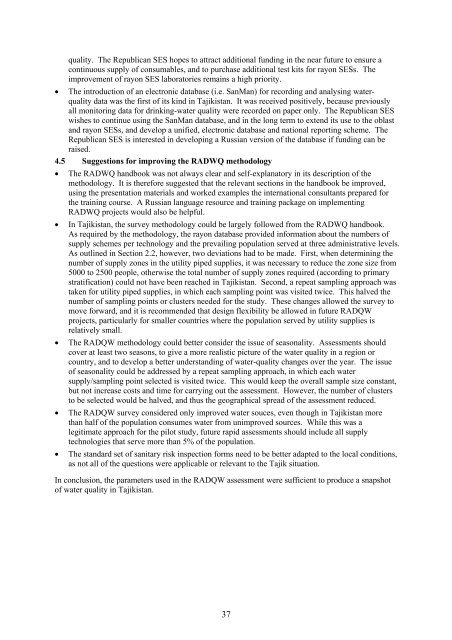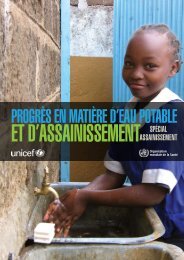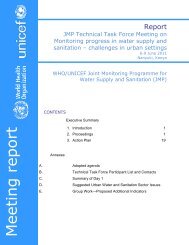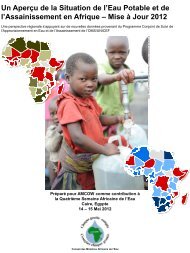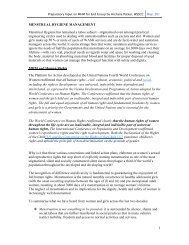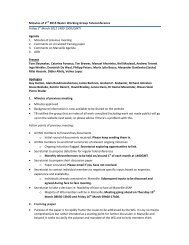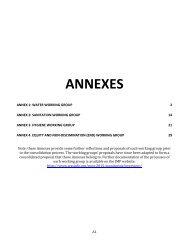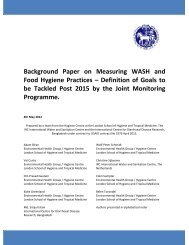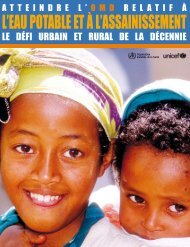rapid assessment of drinking-water quality in the republic of tajikistan
rapid assessment of drinking-water quality in the republic of tajikistan
rapid assessment of drinking-water quality in the republic of tajikistan
Create successful ePaper yourself
Turn your PDF publications into a flip-book with our unique Google optimized e-Paper software.
<strong>quality</strong>. The Republican SES hopes to attract additional fund<strong>in</strong>g <strong>in</strong> <strong>the</strong> near future to ensure a<br />
cont<strong>in</strong>uous supply <strong>of</strong> consumables, and to purchase additional test kits for rayon SESs. The<br />
improvement <strong>of</strong> rayon SES laboratories rema<strong>in</strong>s a high priority.<br />
The <strong>in</strong>troduction <strong>of</strong> an electronic database (i.e. SanMan) for record<strong>in</strong>g and analys<strong>in</strong>g <strong>water</strong><strong>quality</strong><br />
data was <strong>the</strong> first <strong>of</strong> its k<strong>in</strong>d <strong>in</strong> Tajikistan. It was received positively, because previously<br />
all monitor<strong>in</strong>g data for <strong>dr<strong>in</strong>k<strong>in</strong>g</strong>-<strong>water</strong> <strong>quality</strong> were recorded on paper only. The Republican SES<br />
wishes to cont<strong>in</strong>ue us<strong>in</strong>g <strong>the</strong> SanMan database, and <strong>in</strong> <strong>the</strong> long term to extend its use to <strong>the</strong> oblast<br />
and rayon SESs, and develop a unified, electronic database and national report<strong>in</strong>g scheme. The<br />
Republican SES is <strong>in</strong>terested <strong>in</strong> develop<strong>in</strong>g a Russian version <strong>of</strong> <strong>the</strong> database if fund<strong>in</strong>g can be<br />
raised.<br />
4.5 Suggestions for improv<strong>in</strong>g <strong>the</strong> RADWQ methodology<br />
The RADWQ handbook was not always clear and self-explanatory <strong>in</strong> its description <strong>of</strong> <strong>the</strong><br />
methodology. It is <strong>the</strong>refore suggested that <strong>the</strong> relevant sections <strong>in</strong> <strong>the</strong> handbook be improved,<br />
us<strong>in</strong>g <strong>the</strong> presentation materials and worked examples <strong>the</strong> <strong>in</strong>ternational consultants prepared for<br />
<strong>the</strong> tra<strong>in</strong><strong>in</strong>g course. A Russian language resource and tra<strong>in</strong><strong>in</strong>g package on implement<strong>in</strong>g<br />
RADWQ projects would also be helpful.<br />
In Tajikistan, <strong>the</strong> survey methodology could be largely followed from <strong>the</strong> RADWQ handbook.<br />
As required by <strong>the</strong> methodology, <strong>the</strong> rayon database provided <strong>in</strong>formation about <strong>the</strong> numbers <strong>of</strong><br />
supply schemes per technology and <strong>the</strong> prevail<strong>in</strong>g population served at three adm<strong>in</strong>istrative levels.<br />
As outl<strong>in</strong>ed <strong>in</strong> Section 2.2, however, two deviations had to be made. First, when determ<strong>in</strong><strong>in</strong>g <strong>the</strong><br />
number <strong>of</strong> supply zones <strong>in</strong> <strong>the</strong> utility piped supplies, it was necessary to reduce <strong>the</strong> zone size from<br />
5000 to 2500 people, o<strong>the</strong>rwise <strong>the</strong> total number <strong>of</strong> supply zones required (accord<strong>in</strong>g to primary<br />
stratification) could not have been reached <strong>in</strong> Tajikistan. Second, a repeat sampl<strong>in</strong>g approach was<br />
taken for utility piped supplies, <strong>in</strong> which each sampl<strong>in</strong>g po<strong>in</strong>t was visited twice. This halved <strong>the</strong><br />
number <strong>of</strong> sampl<strong>in</strong>g po<strong>in</strong>ts or clusters needed for <strong>the</strong> study. These changes allowed <strong>the</strong> survey to<br />
move forward, and it is recommended that design flexibility be allowed <strong>in</strong> future RADQW<br />
projects, particularly for smaller countries where <strong>the</strong> population served by utility supplies is<br />
relatively small.<br />
The RADQW methodology could better consider <strong>the</strong> issue <strong>of</strong> seasonality. Assessments should<br />
cover at least two seasons, to give a more realistic picture <strong>of</strong> <strong>the</strong> <strong>water</strong> <strong>quality</strong> <strong>in</strong> a region or<br />
country, and to develop a better understand<strong>in</strong>g <strong>of</strong> <strong>water</strong>-<strong>quality</strong> changes over <strong>the</strong> year. The issue<br />
<strong>of</strong> seasonality could be addressed by a repeat sampl<strong>in</strong>g approach, <strong>in</strong> which each <strong>water</strong><br />
supply/sampl<strong>in</strong>g po<strong>in</strong>t selected is visited twice. This would keep <strong>the</strong> overall sample size constant,<br />
but not <strong>in</strong>crease costs and time for carry<strong>in</strong>g out <strong>the</strong> <strong>assessment</strong>. However, <strong>the</strong> number <strong>of</strong> clusters<br />
to be selected would be halved, and thus <strong>the</strong> geographical spread <strong>of</strong> <strong>the</strong> <strong>assessment</strong> reduced.<br />
The RADQW survey considered only improved <strong>water</strong> souces, even though <strong>in</strong> Tajikistan more<br />
than half <strong>of</strong> <strong>the</strong> population consumes <strong>water</strong> from unimproved sources. While this was a<br />
legitimate approach for <strong>the</strong> pilot study, future <strong>rapid</strong> <strong>assessment</strong>s should <strong>in</strong>clude all supply<br />
technologies that serve more than 5% <strong>of</strong> <strong>the</strong> population.<br />
The standard set <strong>of</strong> sanitary risk <strong>in</strong>spection forms need to be better adapted to <strong>the</strong> local conditions,<br />
as not all <strong>of</strong> <strong>the</strong> questions were applicable or relevant to <strong>the</strong> Tajik situation.<br />
In conclusion, <strong>the</strong> parameters used <strong>in</strong> <strong>the</strong> RADQW <strong>assessment</strong> were sufficient to produce a snapshot<br />
<strong>of</strong> <strong>water</strong> <strong>quality</strong> <strong>in</strong> Tajikistan.<br />
37


